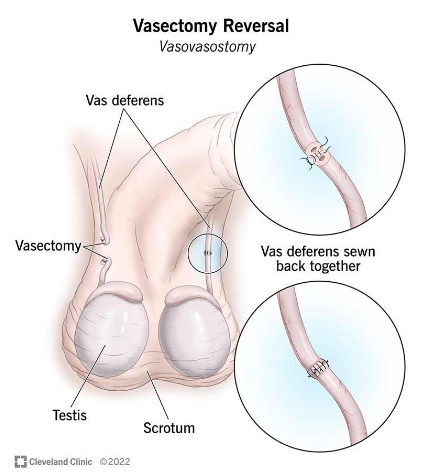Contact the coordinator
+48 75 645 2024
Vasectomy reversal surgery (microsurgery)
Vasectomy reversal is a microsurgery to revoke a vasectomy, in which a surgeon uses a surgical microscope to magnify the vas deferens. During the procedure, a surgeon reconnects each tube that carries sperm from a testicle into the semen. In a vasectomy reversal, your surgeon has to re-join these tubes back together so that sperm can reach the semen when you ejaculate. Following a successful vasectomy reversal, sperm is again present in the semen, and the patient may be able to get his partner pregnant. Vasectomy reversal is a very complexed procedure, more difficult and expensive than a vasectomy. It requires specialized skills and expertise.

Several factors contribute to patients opting for reversal vasectomy:
- a change of perspective on parenthood and a desire to initiate a family due to entering into a new relationship;
- the patient’s inclination towards fertility restoration may stem from a wish to have the option of conceiving biological offspring, even if they do not currently have plans to do so.
- testicular pain may be a potential consequence of a vasectomy in certain instances, and the performance of a reversal vasectomy can serve as a means of alleviating this discomfort.
Techniques for reversal vasectomy
The objective of revasectomics is to circumvent the occlusion site within the seminal duct.
During the medical intervention, the urologist extracts the fluid from the seminal vesicle and analyzes it to ascertain the appropriate surgical operation to be undertaken on the individual. One of the methods employed to reestablish the continuity of the seminal ducts involves suturing the severed segments of the vas deferens. The second method involves circumventing the lock to reconnect the seed pipe with the epididymis.
It is important to consider that reversal vasectomy is a more intricate surgical process compared to vasectomy, with a duration ranging from two to four hours. A qualified medical professional who knows what they’re doing and has the necessary skills must perform the procedure for it to be successful. They also need to use modern equipment, like a high-powered operating microscope, to help them do their job.
Postoperative suggestions
Patients undergoing reversal vasectomy surgery will be provided with comprehensive postoperative instructions by their healthcare provider, tailored to the exact treatment and individual circumstances. The postoperative instructions for scrotum surgeries are comparable to those for other similar procedures, encompassing restrictions on physical exertion, the administration of analgesics, and the use of cold compresses. Patients commonly resume sedentary activities, such as office work, within three days after surgery. On the other hand, engaging in physically demanding tasks is typically postponed until approximately four weeks post-treatment. During the first two weeks, it is advisable to refrain from engaging in physical exertion and to practice sexual abstinence. The initial semen analysis will be conducted around six weeks later. The duration of the reoccurrence of sperm in the ejaculate following a vasectomy varies depending on the specific surgical procedure and the elapsed time since the operation, ranging from one month to a year.
Dr. Alam Bouhaouli at KCM Clinic performs reversal vasectomy.
Netography:
- Vasectomy Reversal, https://my.clevelandclinic.org/health/treatments/15459-vasectomy-reversal, [access: 01.09.2023].
- Vasectomy Reversal, https://stanfordhealthcare.org/medical-treatments/v/vasectomy-reversal.html, [access: 01.09.2023].
Send Request
Register
Visits, hospital procedures
Bariatric Surgery Center
Plastic Surgery Center
Spine Surgery Center
Dental Clinic
OMEGA Imaging Diagnostic Center
Work hours
KCM Clinic Wrocław
Chat KCM Clinic
Locations
KCM Clinic Jelenia Góra
KCM Clinic Wrocław
Parking

